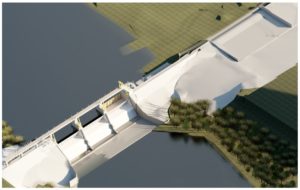Construction Begins on Lake Dunlap Dam
May 17, 2021
SEGUIN, Texas – Construction to restore Lake Dunlap is underway, with the Texas Water Development Board (TWDB) providing the Guadalupe-Blanco River Authority (GBRA) with authorization to issue the formal notice to proceed on Friday, May 14. The estimated timeline for completion of the project is 24 months, pending unforeseen weather delays.
“It’s always a great day on  Lake Dunlap, but today is especially meaningful because it marks the culmination of years of hard work and collaboration between the Preserve Lake Dunlap Association, the Lake Dunlap community and GBRA,” said Lake Dunlap WCID President Doug Harrison. “The approval of a WCID has made today possible, and for that we thank the Lake Dunlap community for their confidence in our partnership and our plan for the future.”
Lake Dunlap, but today is especially meaningful because it marks the culmination of years of hard work and collaboration between the Preserve Lake Dunlap Association, the Lake Dunlap community and GBRA,” said Lake Dunlap WCID President Doug Harrison. “The approval of a WCID has made today possible, and for that we thank the Lake Dunlap community for their confidence in our partnership and our plan for the future.”
Construction will include the replacement of the three bear-trap style crest gates with new hydraulically-actuated steel crest gates. Replacement of the gates will also include structural modifications to the existing spillway structure, upgrades to the mechanical system, upgrades to the electrical distribution power, improved backup power, enhanced instrumentation and controls, improved headwater and tailwater measurement, new video surveillance, the addition of a supervisory control and data acquisition interface, as well as the hardening of the existing earthen dam. San Antonio-based Zachry Construction Corporation has been selected as general contractor for the project through a formal competitive procurement process.
“Today is the result of a collective effort to achieve a common goal – ensuring the longevity of the Guadalupe Valley Lakes,” said GBRA General Manager and CEO Kevin Patteson. “It is the continued partnership, dialogue, and collaboration with the Lake Dunlap WCID, the Preserve Lake Dunlap Association and the greater Lake Dunlap community throughout Comal and Guadalupe counties that have made the restoration of Lake Dunlap a reality, while simultaneously creating a roadmap for several other lakes to follow.”
Current estimated cost of the project is $35 million with GBRA having secured $40 million in bond funding at below market interest rates – 0.03 to 0.29% depending on the maturity date – for the project through the Texas Water Development Board’s Clean Water State Revolving Fund program. Flooding events or other items may occur over the course of construction that lead to additional costs. Per the financing and operation agreements in place between GBRA and Lake Dunlap WCID, the WCID will be responsible for the debt service on the bond, as well as future maintenance and operations costs of the new dams. GBRA will continue to own and operate the dam, while contributing all gross revenues from the sale of hydroelectric power generated by the Lake Dunlap dam back to the WCID.
Put into service between 1928 and 1932, the fifteen spillgates across the six hydroelectric dams that form the Guadalupe Valley Lakes have surpassed their useful life at more than 90 years old. The advanced age of the spillgates increases maintenance costs, causes unreliable operation, and has led to two unrepairable failures, including one at Lake Dunlap in May 2019.
With the hydroelectric operation that previously sustained the dams having operated at an annual deficit for more than a decade, GBRA has and continues to support the efforts of lake associations, residents and property owners to form taxing districts to fund the necessary replacement and continued maintenance and operational cost of the dams. In addition to Lake Dunlap, Lake McQueeney and Lake Placid have also formed WCIDs to fund the necessary replacement of the spillgates on their respective dams, with those projects expected to begin in 2022.
ABOUT
The Guadalupe-Blanco River Authority was established by the Texas Legislature in 1933 as a water conservation and reclamation district. GBRA provides stewardship for the water resources in its 10-county statutory district which begins near the headwaters of the Guadalupe and Blanco rivers, ends at San Antonio Bay, and includes Kendall, Comal, Hays, Caldwell, Guadalupe, Gonzales, DeWitt, Victoria, Calhoun and Refugio counties.